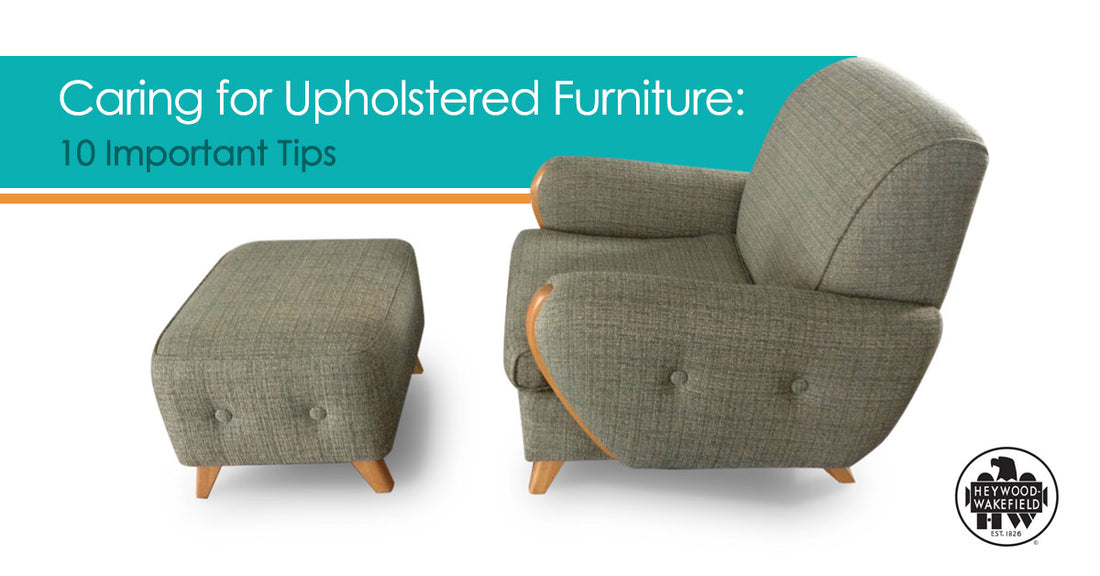
Caring for Upholstered Furniture: 10 Important Tips
Share
When you make a significant investment into a high-quality chair, couch, or other piece of upholstered furniture, it makes sense to protect that investment. Caring for upholstered furniture in some basic ways helps protect it against unsightly damage and helps extend its life for as long as possible.
If you buy upholstered furniture from Heywood-Wakefield, you can rest assured you're getting pieces built to last over a century. Of course, there's only so much we can do on our end. Once we hand-craft your furniture and get it to you, its care is in your hands. There's not much to do, but the simple steps outlined below help ensure you enjoy your beautiful mid-century modern furniture for a lifetime, and can even pass it down to subsequent generations.
Upholstered Furniture Care Tips
- Apply a quality fabric protection product made for use on the type of fabric your upholstered furniture has. Lots of DIY products are available, but consider using a professional; it costs a little more, but the results will be better. Today's advanced stain prevention products don't change the look or feel of the fabric or leave behind an odor. Of course, if you don't like such convenient, invisible protection, you could always go mid-century style and put plastic covers over all your cushions.
- Refrain from eating and drinking on upholstered furniture—at least the dark and greasy stuff. Even the best stain-repelling fabric protectors only do so much. It might be fun to eat that pepperoni pizza and sip your pinot noir on the couch while watching a classic movie from the 1950s, but it's risky. Maybe breaking out those plastic cushion covers isn't such a bad idea.
- Clean up mishaps right away. Generally speaking, use a clean, damp towel to blot—never rub—the spot. A mild dish soap helps with many kinds of stains. If you do use soap or another cleanser, make sure it's OK for use on the type of fabric and test a tiny bit in an inconspicuous location on the furniture to be sure it doesn't affect the material in any undesirable way.
- Vacuum the fabric once per week using a gentle, lightweight vacuum attachment. Be careful around the feet, arms, and other non-upholstered parts of the furniture so you don't scratch or ding it with the vacuum—especially if they're wood.
- Flip and/or rotate seat cushions once every week or two, assuming the design allows for it. This helps even out the pressure and friction the cushion experiences over time. And that, in turn, helps preserve the shape, resilience, and fabric appearance for the long term.
- Swap couch cushion positions every few weeks if they're all the same size. This is particularly important with three-cushion couches like Heywood-Wakefield's mid-century modern Margaret Collection davenport. With three-seat couches, people tend to avoid the middle spot, meaning the two end spots get sat on much more. Swapping the cushion positions periodically goes a long way toward keeping them in great shape for years to come.
- Limit the fabric's exposure to direct sunlight. Over time, the sun's ultraviolet light causes fabric to fade or discolor. Either position your upholstered furniture where it has minimal exposure, or use your window coverings to protect the furniture any time of day when it's necessary.
- Limit upholstered furniture's exposure to atmospheric pollutants too. Tobacco smoke is a biggie, gradually discoloring fabrics and leaving residue on them. Smoke from the kitchen is another common one. When these can't be avoided, provide good ventilation around your furniture. Open windows on opposite sides of the room or your home for air circulation, or use a fan to direct smoke or other pollutants away from the furniture.
- Have your upholstery professionally cleaned every one to three years, depending on how much action and abuse it sees. It's a small inconvenience and expense to pay for how effective this is at keeping your furniture fabric looking like new for many, many years.
- Make your pets and children live in the yard. Just kidding. Mostly.
